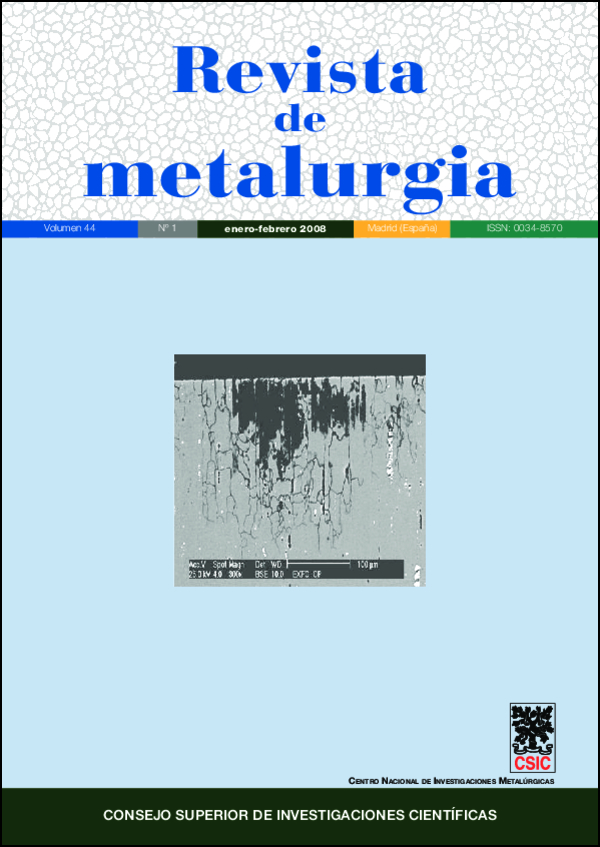Evaluation of the effect of Ni-P coating on the corrosion resistance of the aluminium 7075 T6 alloy
DOI:
https://doi.org/10.3989/revmetalm.2008.v44.i1.96Keywords:
Aluminum 7075 T6, Electroless Ni-P, Corrosion, Exfoliation, PittingAbstract
The aluminum alloy 7075-T6 is a structural alloy widely used for aeronautical applications due to its high relationship between mechanical resistance and weight. Depending upon the environmental conditions, many types of corrosion mechanisms such as intergranular, exfoliation, have been found to occur in aircraft structural aluminum alloys. A significant advance in order to improve the behavior of this alloy is related to the application of the autocatalytic Ni-P coating which confers an excellent corrosion resistance coupled with both reduced erosive wear and higher hardness. The purpose of this work was to investigate the effect of the application of a Ni-P coating on the corrosion resistance of an aluminum 7075-T6 alloy. The results obtained indicated that the application of the Ni-P coatings diminishes the susceptibility to pitting and makes the aluminum 7075 T6 alloy immune to the exfoliation corrosion attack.
Downloads
References
[1] R. Bucci and C. Warren, J. Aircr. 37 (2000) 122-129.
[2] J. Badía, J. Antoranz, P. Tarín, A. Simón and N. M. Piris, Rev. Metal. Madrid 40 (2004) 436-442
[3] E. Stansbury and R. Buchanan, Fundamentals of Electrochemical Corrosion, Ed. ASM International, 1th edition, Materials Park, Ohio, USA, 2000, pp. 297-305.
[4] C. Dervos, P. Vassiliou and J. Novakovic, Rev. Metal. Madrid 41 (2005) 232-239.
[5] R. Zeller III, Corrosion 47 (1991) 692-702.
[6] T. Mimani and S. Mayanna, Surf. Coat. Technol. 79 (1996) 246-251. doi:10.1016/0257-8972(95)02446-8
[7] P. Lo, W. Tsai, J. Lee and M. Hung, Surf. Coat. Technol. 67 (1994) 27-34. doi:10.1016/S0257-8972(05)80023-4
[8] N. Martyak, S. Wetterer, L. Harrison, M. Mcneil, R.Heu and A. Albert Neiderer, Plat. Surf. Finish 6 (1993) 60-64.
[9] G. Lu and G. Zangari, Electrochim. Acta 47 (2002) 2969-2979. doi:10.1016/S0013-4686(02)00198-6
[10] R. Raicheff and V. Zaprianova, J. Mater. Sci. Lett. 19 (2000) 3-5. doi:10.1023/A:1006775025613
[11] P. Bai, Y. Chuang and C. Hu, Mater. Chem. Phys. 82 (2003) 93-100. doi:10.1016/S0254-0584(03)00193-7
[12] S. Lee and H. Liang, Plat. Surf. Finish. 78 (1991) 82-86.
[13] K. Aoki and O. Takano, Plat. Surf. Finish. 73 (1986) 136-141.
[14] R. Diegle, N. Sorensen, C. Clayton, M. Helfand and Y. Yu, J. Electrochem. Soc. 135 (1988) 1085-1092. doi:10.1149/1.2095880
[15] Y. Okamato, Y. Nitta, T. Imanaka and S. Teranishi, J. Catal. 64 (1980) 397-404. doi:10.1016/0021-9517(80)90512-6
[16] E. Van Der Kouwe, Electrochim. Acta 38 (1993) 2093-2097. doi:10.1016/0013-4686(93)80345-Z
[17] ASTM 661-686, Conducting Cyclic Potentiodynamic Polarization Measurements for Localized Corrosion Susceptibility of Iron, Nickel, or Cobalt-Based Alloys, ASTM, 1988, West Conshohocken, PA, USA.
[18] ASTM 634-672, Exfoliation Corrosion Susceptibility in 7XXX Series Copper-Containing Aluminum Alloys (EXCO Test), ASTM, 1972, West Conshohocken, PA. USA.
[19] Z. Longfei, L. Shufu and L. Pengxing, Surf. Coat. Techn. 36 (1988) 455-462. doi:10.1016/0257-8972(88)90173-9
[20] J. Carbajal and R. WhitE, J. Electrochem. Soc. 135 (1988) 2952-2957. doi:10.1149/1.2095468
[21] H. Ashassi–Sorkhabi and S. Rafizadeh, Surf. Coat. Technol. 176 (2004) 318-326. doi:10.1016/S0257-8972(03)00746-1
[22] J. Flis and D. Duquette, Corrosion 28 (1972) 321-330.
[23] R. Baboian, Electrochemical Techniques for Corrosion Engineering, Ed. NACE, Houston, TX, USA, 1986.
[24] R. Zeller Iii and R. Salvati, Corrosion 50 (1994) 457-467.
Downloads
Published
How to Cite
Issue
Section
License
Copyright (c) 2008 Consejo Superior de Investigaciones Científicas (CSIC)

This work is licensed under a Creative Commons Attribution 4.0 International License.
© CSIC. Manuscripts published in both the printed and online versions of this Journal are the property of Consejo Superior de Investigaciones Científicas, and quoting this source is a requirement for any partial or full reproduction.
All contents of this electronic edition, except where otherwise noted, are distributed under a “Creative Commons Attribution 4.0 International” (CC BY 4.0) License. You may read the basic information and the legal text of the license. The indication of the CC BY 4.0 License must be expressly stated in this way when necessary.
Self-archiving in repositories, personal webpages or similar, of any version other than the published by the Editor, is not allowed.
















